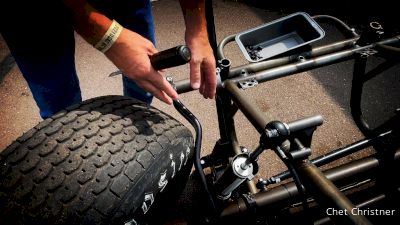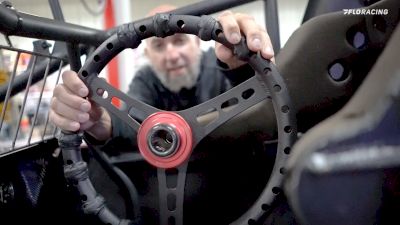What Type Of Cars Are Used For Sprint Car Racing?
What Type Of Cars Are Used For Sprint Car Racing?
We break down the types of cars that are used in various forms of Sprint Car racing throughout the world.

- Auto
- 720
- 480
- 360
- 136
In terms of premier motorsports across the globe, it’s practically common knowledge that NASCAR is the pinnacle of stock car racing and the top tiers of paved open-wheel racing are found in Formula 1 and IndyCar.
Then there’s dirt-track racing, where Sprint Cars are king of the open-wheel ranks. One may ask, what is a Sprint Car, and what types cars of cars are used for Sprint Car racing?
For starters, Sprint Cars are purpose-built cars with no fenders that weigh no less than 1,375 pounds and are capable of pushing 950 horsepower and 9,000 RPMs. Sprint Cars churn out an overwhelming power-to-weight ratio that even outperforms modern day Formula 1 cars and are designed to rip around dirt tracks that typically range from quarter miles to half miles. Sprint Cars are also popular on pavement, especially in Indiana, but the discipline is synonymous with the highest form of dirt-track racing.
What Are The Biggest Sprint Car Races?
What Are The Best Sprint Car Series?
Sign Up To Watch Sprint Car Racing Live On FloRacing
Some of the greatest race cars drivers ever known have raced Sprint Cars, like Indianapolis 500 winners Mario Andretti, A.J. Foyt, Parnelli Jones, Al Unser Sr., Al Unser Jr., and Johnny Rutherford, as well as NASCAR Cup champions Jeff Gordon, Tony Stewart and Kyle Larson.
What makes a Sprint Car unique beyond their sheer power-to-weight ratio is that they don’t have transmissions or starters, so push trucks are used to get the car in gear and ignite the engine. Sprint Cars are also fuel-injected by methanol and use three different sized tires, with the right-rear being considerably the largest. This is called stagger, which helps the car turn left and maneuver through the corners at rapid speed.
Though these characteristics are common in every Sprint Car, there are two different classes of these beastly, purpose-built machines. Let’s take a look at where you kind find the different types of Sprint Cars, whether that’d be through a particular series or region across the country or even oversees.

- Auto
VIDEO: Go into the cockpit of a Non-Winged Sprint Car with FloRacing's Chet Christner.
What Is A Non-Wing Sprint Car?
A conversation about Sprint Cars must begin with its traditional wingless or non-winged archetype. Though winged Sprint Cars are more widespread and seemingly more popular throughout the world, wingless Sprint Cars are the reason the discipline exists in the first place.
The United States Auto Club, simply known as USAC, is the most prominent sanctioning body of the traditional, wingless machines. USAC’s AMSOIL National Sprint Car Series is the national touring series where the top drivers of the discipline do battle around the country.
USAC also sanctions the NOS Energy Drink National Midget and Silver Crown Series, two divisions that are important to know in the family tree of Sprint Car racing. Sprint Cars derive from Champ Cars, which are now preserved in the form of the Silver Crown Series, a 14-race tour that races on dirt and pavement.
Silver Crown cars are much larger than Sprint Cars, are roughly 200 pounds heavier, and carry a 75-gallon fuel cell as opposed to Sprint Car racing’s typical 22-gallon fuel cell. Thus, Silver Crown cars are made for long-distance races and tailor-made for 100-mile races on mile-long dirt tracks. Engineering over time has allowed these cars to race on pavement tracks like Lucas Oil Indianapolis Raceway Park, Madison Int’l Speedway in Oregon, Wis., Winchester (Ind.) Speedway, Toledo (Ohio) Speedway, and the 1.25-mile World Wide Technology Raceway outside St. Louis.
The first Champ Car Series in 1905 under the American Automobile Association was actually the first form of professionally organized motorsports in the United States. The AAA sanctioned races through 1955 until the federation withdrew from auto racing. That’s when USAC as its known today formed in 1956.
As the Champ Car Series eventually evolved into the modern day IndyCar Series, Midget Cars and Big Cars (now known as Sprint Cars) were established as grassroots disciplines for the Indy Roadsters. Midget Cars first came along in the 1930s as 4-cylinder cars that raced on board tracks once used for bicycle racing.
Midget Cars still use 4-cylinder engines to this day and weigh roughly 900 pounds while outputting roughly 300 horsepower. Sprint Cars were founded shortly after Midget Cars when V8 engines came into the fold in the late 1950s.
The dynamics of the modern day Sprint Car, aside from safety and technological improvements, are practically a mirrored image to Sprint Cars from the early days roughly 75 years ago.
VIDEO: FloRacing's Chet Christner breaks down the basic components of a Sprint Car.
What Is A Winged Sprint Car?
These open-wheel beasts are basically traditional Sprint Cars assembled with front and top wings. Why the spacecraft-looking wings, you might ask?
The front and top wings serve two purposes: safety and added downforce. Because Sprint Cars are an open cockpit, a top wing lessens the impact of a collision should a driver go for a tumble. More downforce also makes the cars easier to control and because the cars are more planted to the ground, faster speeds are the result.
Wings on Sprint Cars didn’t become a thing until the 1970s when drivers back then tampered and toyed with the high-powered machines to see how they’d perform with greater downforce. The World of Outlaws Sprint Car Series was then formed in 1978, further professionalizing winged Sprint Car racing.
Along with the WoO, the All Star Circuit of Champions, and High Limit Sprint Car Series are two other national series popularly showcasing winged Sprint Cars. There are numerous of lower-tier tours as well, like the American Sprint Car Series and United Racing Club, which utilize 360ci engines as opposed to the top-tier 410ci engines.
Winged Sprint Cars are also common regionally in California, Iowa, Ohio, and Central Pennsylvania. In California, the NARC King of the West and Sprint Car Challenge Tour are the West Coast’s cornerstone tours. In Iowa, Knoxville Raceway’s championship series is perhaps the most grandest weekly title to win in America.
Ohio and Pennsylvania, meanwhile, are two states that have respective regional points series. Winged Sprint Car racing can also be found in Australia, Canada, New Zealand, and South Africa.